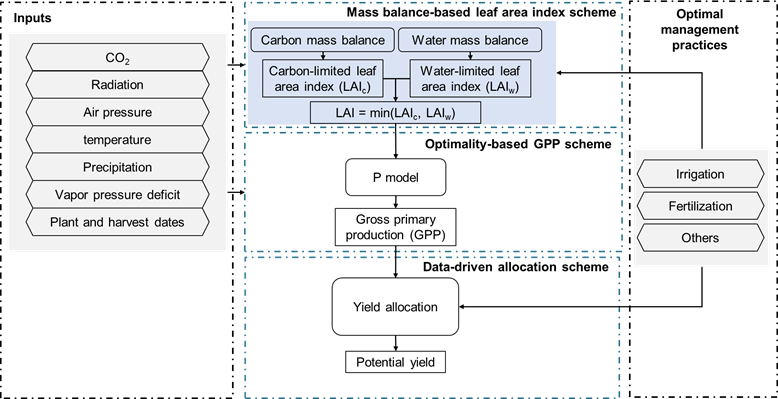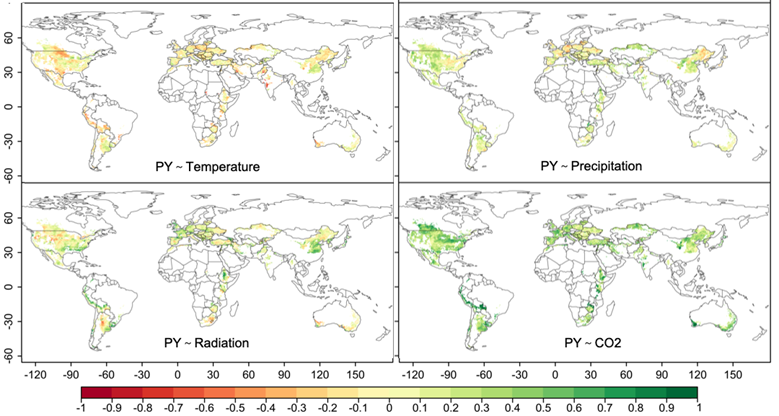As crop yield is heavily influenced by climate, agriculture has remained dependent on climate since ancient times. With scientific and technological progress, the influence of climate on agricultural production has been alleviated to some extent. Nonetheless, the dependency on climate still exists, because wide control and change of climate is impossible for the time being. Especially in the technologically underdeveloped areas, the impact of climate change on crop yield is essential to the realization of UN’s goal of “zero hunger”. What changes have taken place in the dependency on climate in the context of global climate change?
Potential yield, as the ceiling of crop yield, reflects the yield under the best climatic conditions, and is an important object of food security evaluation. However, the existing potential yield evaluation methods based on statistical model and process model have poor reliability, stability and universality, and cannot accurately estimate and reasonably evaluate the annual changes of potential yield under the influence of climate.
In the light of the above problems, the research group led by Associate Professor Wang Han from the Department of Earth System Science of Tsinghua University evaluated the change of global potential wheat yield and its response to climate in the past 40 years (1981-2016) by using the independently developed optimality-based PC model. These research results have been recently published in a paper titled “Optimality-based Modelling of Climate Impacts on Global Potential Wheat Yield” in the Environmental Research Letters.
Different from traditional crop growth models, PC model, guided by the principle of ecological optimality, is to mathematically express the general law and internal mechanism of crop growth. The model includes two modules: carbon assimilation and carbon distribution. The former consists of an optimality-based universal productivity model (P model) and a mass balance-based leaf area index scheme; the latter is used to simulate the nonlinear productivity-yield allocation and the influence of artificial management on the allocation ratio. The PC model framework and its verification results at China’s agricultural sites have been published in a paper titled “Extending a First-Principles Primary Production Model to Predict Wheat Yields” in the Agricultural and Forest Meteorology. Based on the original framework of PC model, this study introduced the water-limited leaf area index, and simulated the potential wheat yield in rain-fed areas around the world.

Fig. 1 Structure of PC model (P model for Crop)
In this study, the simulation results of global potential wheat yield by PC model and by ISIMIP process model were compared. Upon the comparison with EARTHSTAT benchmark, it is found that PC model not only simplifies the empirical parameters and secondary processes of complex models, but also effectively improves the simulation of the spatial pattern and magnitude of potential yield (Fig. 2).
Fig. 2 Multi-Model Comparison of Potential Wheat Yield in 2000 (with EARTHSTAT data as the benchmark)
The evaluation results of climate effects show that the potential yield of most wheat growing areas in the world declined to varying degrees due to global warming. The effects of precipitation and radiation changes on potential wheat yield were opposite in arid areas and humid areas: the radiation increase in arid areas intensified the water stress of wheat growth, thus decreasing the potential wheat yield; the precipitation increase in humid areas may lead to floods, which adversely affected wheat growth. Besides, the increase of carbon dioxide concentration in the atmosphere also raised the potential wheat yield to some extent (Fig. 3). In the same period, the climate effects on actual wheat yield were consistent with those on potential wheat yield, which once again reveals the great influence of climate change on agricultural production and the urgency of reliable prediction and evaluation of climate effects. These evaluation results provide strong support for global food security evaluation under the background of climate change, and offer a good reference for the potential yield evaluation for other crops.

Fig. 3 Partial Correlation between Potential Wheat Yield (PY) and Temperature, Precipitation, Radiation and CO2
The PC model independently developed by Wang Han Research Group is characterized by simple structure, few empirical parameters and strong universality. Compared with the complex process model, PC model contains more ecological adaptation mechanisms of plants, which simplifies the model structure and reduces model parameters while ensuring high-quality simulation. This not only improves the model stability and applicability in different regions, but also greatly increases the computing speed and significantly saves computing resources.
Qiao Shengchao, a doctoral student in the Department of Earth System Science of Tsinghua University, is the first author, and Associate Professor Wang Han of the Department of Earth System Science of Tsinghua University is the corresponding author. The collaborators include Professor I. Colin Prentice and Professor Sandy P. Harrison, who are distinguished visiting professors of Tsinghua University. This study has received the support from the “Plant Function Adaptation and Simulation” Project of the National Natural Science Foundation of China, the “Research on Problems Related to Nature-based Solutions” of Tsinghua University Initiative Scientific Research Program, etc.
Contributed by: Qiao Shengchao
Edited by: Wang Jiayin
Reviewed by: Wu Haiping
Paper details:
Qiao, S., Wang, H., Prentice, I. C., & Harrison, S. P. (2021). Optimality-based modelling of climate impacts on global potential wheat yield. Environmental Research Letters. https://doi.org/10.1088/1748-9326/ac2e38
Qiao, S., Wang, H., Prentice, I. C., & Harrison, S. P. (2020). Extending a first-principles primary production model to predict wheat yields. Agricultural and Forest Meteorology, 287, 107932. https://doi.org/10.1016/j.agrformet.2020.107932